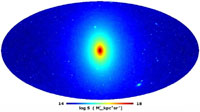Simulaties voorspellen vindplaats donkere materie

Een internationaal team van sterrenkundigen, onder wie de Groningse astronome Amina Helmi, heeft de locaties in de Melkweg voorspeld, waar de kans het grootst is dat er donkere materie wordt gedetecteerd. Op basis van simulaties, uitgevoerd met Europa's grootste supercomputers, tonen zij aan dat niet de satellietstelsels van de Melkweg, maar het gebied rondom het centrum van de Melkweg, de beste plek is om te speuren naar de zwakke gammastraling die wordt uitgezonden door de raadselachtige donkere materie. In een Nature-artikel dat 6 november 2008 verscheen, doen zij de aanbeveling dat NASA de nieuwe gammatelescoop Fermi op deze gebieden moet richten.
Donkere materie is materie die wel zwaartekrachtsinvloed uitoefent, maar tot op heden niet is waargenomen met telescopen. Kosmologen nemen aan dat zo'n 85 procent van alle massa in het heelal uit de mysterieuze donkere materie bestaat, geen gewone atomen en moleculen, maar onbekende elementaire deeltjes die wel massa hebben, maar geen straling produceren. Onder de juiste condities zouden deze deeltjes wel voldoende gammastraling kunnen uitzenden om door Fermi te worden gezien.
De donkere materie-halo rond een sterrenstelsel als onze Melkweg bevat meer dan een triljoen zonsmassa's. De simulaties laten zien dat de enorme halo van de Melkweg is ontstaan door een serie van botsingen en versmeltingen van miljoenen veel kleinere 'brokken' donkere materie die bij de Oerknal zijn ontstaan. Sommige hebben het proces overleefd; de grootste herbergen de bekende satellietstelsels van de Melkweg, zoals de Grote en Kleine Magelhaense Wolk en het dwergstelsel Sagittarius.
Gammastraling wordt geproduceerd in gebieden met een grote dichtheid van donkere materie. De straling komt vrij wanneer de deeltjes botsen en vernietigd worden. Veel kosmologen hebben beargumenteerd dat de satellietstelsels de ideale plek vormen voor Fermi om gammastraling te zoeken, vanwege de hoge dichtheid in hun centrum. De nieuwe simulaties tonen echter aan dat Fermi beter de Melkweg in zou kunnen kijken (vanaf de zon gezien), maar dan 10 tot 30 graden van het centrum vandaan. Daar, zo voorspellen de astronomen, is de kans het grootst dat een gevarieerd en karakteristiek patroon van gammastraling wordt ontdekt.
De simulaties zijn uitgevoerd met onder meer Stella/Bluegene, de LOFAR supercomputer bij de Rijksuniversiteit Groningen.
Meer informatie: prof. dr. Amina Helmi, Kapteyn Instituut, Rijksuniversiteit Groningen
Meer beelden zijn te vinden op http://www.mpa-garching.mpg.de/aquarius
Artikel: Prospects for detecting supersymmetric dark matter in the Galactic halo, Nature 456, 73-76 (6 november 2008)
Meer nieuws
-
11 december 2025
Stormachtige planeten en een onverwachtse atmosfeer
-
09 december 2025
RUG-hoogleraar bij COP30: ‘Het is altijd drama’
